
Talented Vietnamese badminton player Vu Thi Trang, a native of the northern province of Bac Giang, enjoyed victory as she claimed second place in the women’s singles event at the Maldives International Challenge 2019.
During the tournament’s final round on September 29, Thi Trang, world No.64, went into the tie as favourite against her lower-ranked opponent, Iris Wang of the United States, world No.102.
Despite being the underdog throughout the tournament, Wang had shown plenty of determination to make the final having beat No.1 seed Yigit of Turkey, world No.35, in the semi-final round.
In the final, No.3 seed Thi Trang, was beaten by Iris Wang after two sets with scores of 15/21 and 14/21.
Archaeologists dig into past year's findings
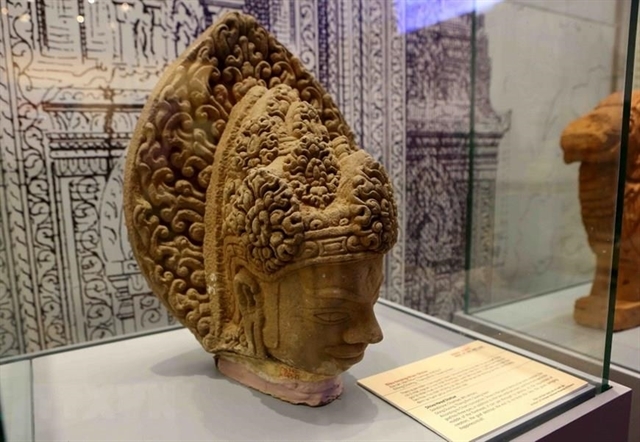 |
| A statue of the head of Shiva belonging excavated by Vietnamese archaeologists this year. |
Vietnamese archaeologists gathered at a conference in Hà Nội on Thursday and Friday to discuss the greatest discoveries of the year.
The conference was hosted by the Institute of Archaeology – Vietnam Academy of Social Sciences.
Addressing the event, Doctor Đặng Xuân Thành said: “This conference provides us with a chance to exchange, debate and evaluate our cultural heritage. The Vietnam Academy of Social Sciences appreciates the efforts of the Institute of Archaeology and other organisations for holding our 54th annual conference,” he said.
Doctor Bùi Văn Liên from the Institute of Archaeology revealed that the conference had received 360 reports this year as a result of the hard work carried out by the sector.
They included new discoveries and studies on the Stone Age, the highlights of which were the excavation of C6-1 volcanic cave in the central province of Đắk Nông and studies on anthropological components, pollen spores, graves and animal remains. The excavation results confirmed C6-1 was a residential area containing a workshop to create tools as well as graves.
Other notable excavations were carried out at Luy Lâu Citadel in the northern province of Bắc Ninh, which revealed the region used to be a residential area during the Chinese invasion of Việt Nam.
Another major excavation was conducted at Đồng Miễu Chăm Tower in the central province of Phú Yên. Based on the study, scientists determined the tower was first built in the fourth century and then rebuilt in the fifth century, which makes it the earliest remnant of a Chăm Pa tower ever found.
Members of the Vietnam Maritime Archaeology Project carried out a study on Quan Lạn Island in the northern province of Quảng Ninh, in addition to the second excavation of Đồng Chổi to clarify its value before Vân Đồn becomes an international harbour.
The results found it had been used as a burial ground in the New Stone Age.
The highlight of the year was part of a five-year collaboration between Việt Nam and Russia at archaeological sites in An Khê in the central highlands province of Gia Lai. Some of the objects unearthed there indicate An Khê was one of the most ancient birthplaces of human beings.
According to Doctor Nguyễn Gia Đối, acting director of the Institute of Archaeology, these studies had positive social effects and aimed to reveal history, preserving and promoting the cultural identity of the nation. — VNS
Fake medical record makers arrested
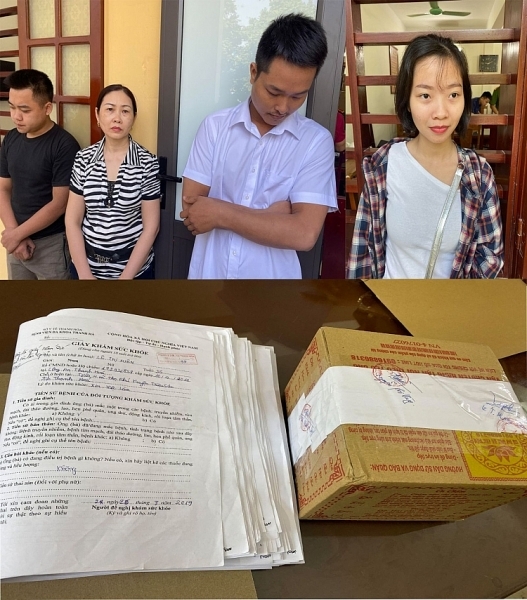 |
|
Four people allegedly making fake medical records were arrested by Thanh Hoá Province Police. — Photo tuoitrethudo.com.vn
|
Four people were arrested over allegations of forging health certificates and medical records, Thanh Hoá Province Police said on Thursday.
Officers searched the homes of Lê Bá Nam and Nguyễn Thị Thanh in Quảng Thịnh Commune, Nguyễn Thị Mai in Lam Sơn District, Thanh Hoá City and Lê Ngọc Đạt in Hoằng Thành, Hoằng Hoá District.
Police discovered many fake health certifications and medical records claiming to be from Thanh Hà General Hospital and Thanh Hoá Transport Hospital along with fake stamps.
According to initial findings, the four people are alleged to have sold the fake documents online for between VNĐ70,000 to VNĐ150,000 (US$3 to 6.46) each.
Investigations are continuing.
Three workers die on steel furnace in Bình Dương Province
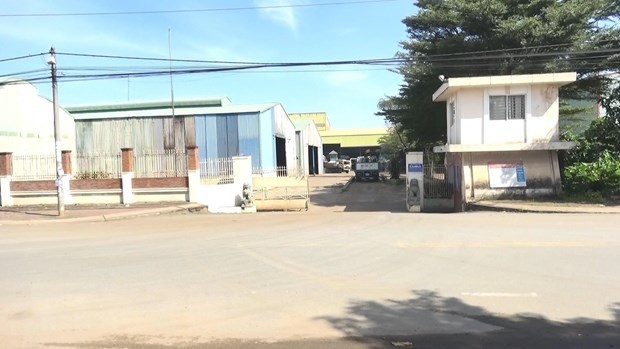 |
|
Three workers died on Monday in Samina Steel Ltd Co's furnace, Bình Dương Province.
|
Three workers at a steel plant in the southern province of Bình Dương have died after inhaling poisonous fumes.
The southern province of Bình Dương’s Department of Labour, Invalids and Social Affair is coordinating with the provincial police to investigate the case.
The three reportedly suffered suspected asphyxiation while they were repairing a furnace at Samina Steel Ltd Co, located at Tân Bình Ward, Dĩ An Town, of the province on Monday.
A leader of the department told Vietnam News Agency on Friday the accident occurred when two workers of the Samina Steel Ltd.Co, Trần Văn Bay, 41, and Đào Biển, 31, discovered a leak when they entered a steel furnace measuring 2.2m in height and 1.5m in diameter.
On Monday, Trần Văn Bay took Bùi Anh Duy, a 37-year-old electrician of the company to show him the leak on the furnace. It appears there ventilation inside wasn't switched on and the group passed out.
Sensing the danger, workers standing outside the furnace area did not climb inside, instead they used long poles to hook the victims’ clothes then pulled each one out. All three victims were taken to Dĩ An Town Hospital.
According to a local police report, when the victims were rushed to the emergency room in the hospital, all three workers were in cardiac arrest. One of the men died a short time later, while the two others died after being transferred to different hospitals.
Bay and Biển were residents of the Mekong Delta Province Sóc Trăng while Duy was of Bình Dương Province.
Zero workplace accidents campaign kicks off in HCM City
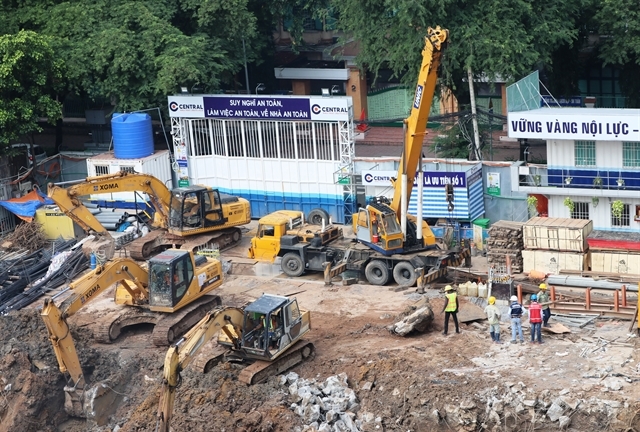 |
|
Workers at a construction site in HCM City’s District 3.
|
A campaign launched in HCM City on Friday calls on at least 100 factories in southern Việt Nam to set the ambitious target of 100 days without occupational accidents.
The "100 days without accidents" campaign will run until the end of this year, and seeks to ensure there are not even minor injuries or near misses.
It is part of the International Labour Organisation (ILO)’s Sustaining Competitive and Responsible Enterprise (SCORE) programme in Việt Nam.
Factories that sign up for the campaign will participate in SCORE Training, which combines classroom training, factory consulting visits and awareness-raising activities to help companies and workers improve safety standards.
Chang-Hee Lee, ILO Việt Nam director, said "safety and health are fundamental rights of workers".
“So employers and workers should be well aware of the risks and take necessary measures to prevent them.”
Work-related accidents killed more than 1,000 workers and injured 8,200 others last year, according to the Ministry of Labour, Invalids and Social Affairs’ occupational safety report.
“Ensuring the safety of workers would contribute to businesses’ development,” Trần Ngọc Liêm, deputy director of the VCCI’s HCM City office, said.
Stephan Ulrich, regional manager of the SCORE programme, said investing in the safety of workers brings excellent returns in the form of healthier and more motivated and productive workers, and avoids costs associated with accidents for companies as well as society as a whole.
"Successful businesses are which continually improve their production systems along with their safety management systems," he said.
It estimated that losses in terms of compensation, lost work days, interrupted production, training and reconversion and healthcare expenditure represent 3.94 per cent of the world's annual GDP.
Golf tournament offers prize money of 4.3 million USD
 |
| FLC Golf Links Sam Son will host one of Vietnam's biggest ever events, the FLC Homes Golf Tournament 2019, in October. (Photo from organisers) |
The FLC Homes Golf Tournament 2019 will have a huge prize fund of 100 billion VND (4.3 million USD) this year, according to the organisers.
Prizes will include four European-styled villas and 16 luxury cars.
This year's event is expected to attract 1,200 athletes competing at the FLC Golf Links Sam Son in central Thanh Hoa province from October 10-13.
Players will be divided into three groups for men based on their handicaps and one category for women.
“Golf has a lot of potentials and is developing strongly in Vietnam. We hope the tournament will be a good start for us to continue organising other annual events,” said Nguyen Hoai Son, General Director of FLC Homes Company./.
Tay Ninh province promotes culture, trade, tourism in Hanoi
 |
|
The Great Divine Temple of Caodaism, one of the destinations in Tay Ninh province.
|
Unique performing arts of ethnic minority people in the southwestern province of Tay Ninh started the Tay Ninh Day in Hanoi.
The opening ceremony took place on September 27 at Ly Thai To flower garden near Hoan Kiem Lake.
The performance highlighted various intangible cultural heritages of the province such as ‘don ca tai tu’ (Southern instrumental music and singing), Chhay-dam drum dance and Cham dance.
With the theme Beauty of Tay Ninh, the three-day festival helps promote Tay Ninh’s unique culture, trade and tourism potential, as well as attracting investment to the province.
The event is co-organised by the People Committees of Hanoi and Tay Ninh, and the national flag carrier Vietnam Airlines as part of activities to celebrate the 65th anniversary of the capital’s Liberation Day (October 10).
A photo exhibition on provincial socio-economic and cultural achievements, natural landscapes, historical sites, traditional craft villages, and festivals will be held at the pedestrian zone nearby.
The provincial Department of Culture, Sports and Tourism set up 30 pavilions offering local food specialties, introducing tourism packages as well as performing songs and dances during the festival.
Visitors can try various delicacies such as soursops, durians, banh trang (rice paper), smoked beef and shrimp salt.
Various enterprises and agencies are attending the exhibition including Ba Den Mountain tourist site, Lo Go Xa Mat National Park and national special relic of the base of Central Committee for South Vietnam.
As a part of the festival, the Vietnam Airlines Festa programme comprises booths of Vietnam Airlines, Hanoi Tourism Department and other partners introducing tourism and cultural products of Hanoi. Visitors also have a chance to buy tickets at low fares./.
Project raises awareness of environmental issues through cultural activities
 |
|
The Citizen Earth project will begin with a walking tour led by architect Nguyen Vu Hai on October 5. The tour will take participants from Cho Gao (in this picture) to Bach Ma temple and Hang Dau water tower - PHOTO: COURTESY OF ORGANIZER
|
A project that aims to raise awareness of critical environmental issues and encourage actions to make positive changes through artistic, cultural, educational, and community-friendly activities will kick off early next month.
The Citizen Earth project, as part of the Cultural and Artistic Responses to Environmental Change program, will be implemented by Six Space and its partners and sponsors such as the Goethe-Institut, Mekong Cultural Hub, and Prince Claus Fund from 2019 to 2020.
The project invites artists, historians, anthropologists, environmental researchers, scientists, engineers, and educators to engage in discussions on art, the environment and sustainability.
The group will conduct research on various sites affected by climate change or facing critical environmental issues, and then produce artistic interventions and activities in collaboration with related communities.
A wide range of activities will take place to bridge the gap between the experts and the audience, and the knowledge producers and the knowledge receivers.
The first series of events taking place on October 5 will be included in a 16-hour journey across multiple sites in Hanoi, inviting participants to explore the tastes, colors, historical and cultural stories and the way nature is entwined within a city that is undergoing rapid transformations brought along by globalization.
The activities include a walking tour from Cho Gao to Bach Ma temple and Hang Dau water tower, a workshop on soil color, launch of the program “What will you do with a seed?”, and a seminar titled “When Technology meets Art”.
Six Space is an artist-run art space that endeavors to provide diversity in approaches and perspectives to art and creative practices in Hanoi.
Runways, taxiways in Noi Bai, TSN need urgent upgrade: ministry
 |
|
A view of a deteriorating runway at Noi Bai International Airport
|
The Ministry of Transport has called for funds to renovate and upgrade the deteriorating runways and taxiways of the Noi Bai and Tan Son Nhat international airports due to the increased risk they pose to aircraft using them.
The ministry, which is responsible for the repair and maintenance of runways and taxiways at all 21 airports in Vietnam, noted in an urgent message to Prime Minister Nguyen Xuan Phuc that the country’s two largest airlines are under considerable pressure due to the increasing demand for air travel.
Also, their runways and taxiways have been used beyond their designed capacities, resulting in shifts, fractures, road subsidence and mud emergence at expansion joints, as well as the flaking and cracking of concrete slabs.
The Airports Corporation of Vietnam has funded minor repairs of the damaged infrastructure, but this is a temporary fix, according to the ministry.
Ministry officials added that if the renovation and upgrade of the two airports, Noi Bai in Hanoi and Tan Son Nhat in HCMC, are not completed soon, flight operations would be at risk.
Therefore, the ministry suggested the prime minister consider allocating 10% of the reserve capital from the medium-term public investment plan for the 2016-2020 period to finance the repairs of the airports’ runways and taxiways.
The Civil Aviation Authority of Vietnam (CAAV) stated in a report last month that two runways at the Hanoi-based Noi Bai airport have sustained cracks and deformations, and one of them is dented with two tire marks, each measuring one meter in width. Taxiways linking these runways are also deteriorating.
CAAV deputy head Pham Van Hao told the Tuoi Tre newspaper that the degradation of the airport infrastructure increases with each flight served at the airdrome.
“The two runways and some taxiways have been in use for a long time, and the flight frequency at the airport has been rising steadily, which only worsens the deterioration,” he said.
Flights to and from the airport are facing safety risks, due to the degradation of runways and taxiways there. Work should be done quickly as the facilities may become too damaged for further use, according to the aviation watchdog.
Long Thanh airport may face delays
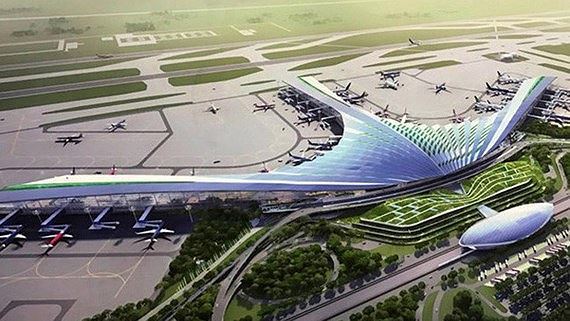
An artist’s impression of Long Thanh International Airport project in Dong Nai Province. The airport project may face delays as over 1,400 households have yet to hand over their land - PHOTO: ACV
Over 1,400 households have yet to hand over their land to the investor in the Long Thanh International Airport project, making it hard for the megaproject to proceed as scheduled, Thanh Nien newspaper reported.
Nguyen Dong Thanh, director of the Land Fund Development Center of Dong Nai Province, on September 16 told the newspaper that the site clearance process is being sped up to ensure cleared land could be handed over as scheduled on December 31.
However, the greatest hindrance to site clearance is the households, Thanh said, adding that a mere 382 households have been checked and measured.
As most of the houses were given or sold to the current owners under written contracts and many of the owners do not live in these houses, uncovering information about the houses has been difficult, with over 1,400 houses awaiting assessments.
The center had earlier informed the homeowners of the site clearance process to make room for the airport. If information on the owners and their homes is not provided, the center will check and measure the houses without the owners’ consent, in line with prevailing regulations, Thanh remarked.
Dang Hung Vo, former deputy minister of Natural Resources and Environment, said that the total land needed for the construction of the Long Thanh airport project is over 5,580 hectares, 85% of which is farming land.
The investment for resettlement areas totals VND5.57 trillion, Vo said.
Vo said the solutions are expected to be costly, so it is necessary to change the methods of compensation and resettlement and use land as compensation instead of money.
Kenh Te Bridge expansion completed
Based on long-term plans to improve the local infrastructure and ease traffic between the city center and its growing southern suburbs, Kenh Te Bridge, connecting Districts 4 and 7 in HCMC, has been widened to 14 meters from the original 12 meters.
Nguyen Vinh Ninh, deputy director of the HCMC Management Board of Urban Traffic Projects, said that the expansion of the bridge has been completed. The bridge’s expansion joints will be completed at the end of this month and do not affect traffic flow, said Ninh.
Kenh Te Bridge connects Khanh Hoi Street in District 4 with Nguyen Huu Tho Street in District 7, forming an axis road from the city center to the Saigon South area, covering Districts 4, 7 and 8 and the outlying district of Nha Be.
In recent years, more real estate projects have started to spring up in the Saigon South area, resulting in a large influx of new residents.
Meanwhile, the area is separated from the city center by four canals: Tau Hu, Ben Nghe, Kenh Doi, and Kenh Te. People have to cross as the bridges of Nhi Thien Duong, Chanh Hung, Chu Y, Nguyen Van Cu, Tan Thuan or Kenh Te to travel to and from the city center.
However, these bridges are under severe strain as they are too narrow to handle the high volume of vehicles crossing them each day. Worse still, the bridges became bottlenecks for traffic when streets linking to them were widened.
Accordingly, the municipal Department of Transport in 2017 started the expansion of the Kenh Te Bridge to reduce traffic congestion, with an investment of VND90 billion.
Besides this, expansion works will be executed on streets linking the city center with the southern districts, as part of the city’s transport development plan for 2020. Additional bridges, Kenh Te 2 and Nguyen Khoai, will be built to ease traffic connections between the two areas, according to the department.
Large residential areas needed to meet increasing demand: expert
Large-scale residential zones need to be developed in the suburban parts of HCMC and across its neighbors to meet the growing demand for housing, given the high population density in the southern metropolis, according to an expert at a workshop here today, September 17.
The event was aimed at seeking housing solutions to serve the predicted population growth of one million people every five years for the 2021-2035 period in the country’s busiest city.
The municipal chairman, Nguyen Thanh Phong, said in his opening speech that the city is facing a serious challenge from the large population. He cited data as indicating that the city has a fixed population of some nine million people, but more than 13 million are living, studying and working here.
“The population is large, but its distribution is uneven. The average population density of the city is 14.7 times higher than that of the country, and it is mainly concentrated in the central districts,” he stated.
He noted that the fast population growth, with an annual increase of 200,000 people, has led to considerable pressure on urban management, which has set higher requirements for technical and social infrastructure, especially for housing.
Citing statistics from the HCMC Department of Construction, Chairman of the HCMC Real Estate Association (HoREA) Le Hoang Chau remarked that more than 476,000 households do not own their homes or are living with relatives, accounting for a quarter of all households.
Low-income earners find it difficult to secure houses since there are shortages of small- and medium-sized commercial houses, social housing and apartments for lease at low prices, according to Chau.
He pointed out that housing prices are 20 to 25 times higher than the residents’ average annual income, while the difference in developed countries is five to seven times only.
He claimed that except for a social housing loan package worth VND30 trillion for the 2013-2016 period, the Government has not issued a credit policy enabling low and medium earners to purchase houses.
In HCMC, the authority has helped local State employees who wish to take housing loans of up to VND900 million (some US$38,000) each, with an annual interest rate of 4.7%, repayable in 15 years. So far, some VND1.5 trillion (US$64.5 million) has been disbursed.
Chau stressed that this policy should be made accessible to all low earners, not just State workers, so that more people can buy homes.
The HoREA chairman also suggested the city develop affordable housing projects in satellite towns that provide adequate services and utilities and have public transport systems, such as metro lines, monorails and buses.
In these metropolitan areas, it is necessary to build affordable social housing for middle earners and high-class commercial apartments for high earners, he added.
He also proposed the development of large-scale residential zones, with each project covering more than 50 hectares, in the suburban part of the city.
It is essential to develop similar residential areas in the city’s adjacent provinces, such as Binh Duong, Dong Nai and Long An.
He explained that once these satellite towns are established, they will help redistribute the population and reduce the number of migrants to the city.
HCMC: Capital revision procedures cause Metro Line No.1 delays
 |
| A view of the first metro line project in HCMC. The city has sought to explain why the opening of its first metro line project has been delayed |
The government of HCMC, explaining the rescheduling of the opening of Metro Line No.1 until late 2021, said more time is needed to complete legal procedures to revise up the project’s total investment cost, as required by law.
The project, which was begun in March 2007, was to be completed in 2017 and opened to traffic in 2018. Its launch was then postponed until 2020 due to delays in site clearance, adding that the city had to revise a technical design for the Ben Thanh Market underground station to be connected with metro lines No.1, 2, 3a, and 4.
However, the municipal urban railway authority MAUR, after checking the time required for the adjustment procedures, decided to reschedule the launch until the last quarter of 2021, the municipal government said in a report sent to the Ministry of Transport.
The city mentioned obstacles arising while carrying out the project, saying that it has yet to meet requirements to receive State funding for the project due to incomplete legal procedures.
The city government, since 2017, has used its budget to make advance payments for the contractors of the project.
The city also petitioned the Ministry of Planning and Investment to release the remaining official development assistance capital from the State budget, worth over VND3.7 trillion for the project, after its capital adjustment is completed, to pay for contractors.
The timely disbursement is aimed at ensuring adequate funding to carry out the project as scheduled, and avoid possible construction suspensions due to late payments for contractors.
Hanoi to ask taxis to operate by zone
 |
|
Taxi cabs operate in Hanoi City. The Hanoi government is due to issue a set of regulations on taxi operations, setting specific zones for taxis
|
The Hanoi government is due to issue a set of regulations on taxi operations, setting specific zones for taxis based on administrative boundaries.
A source from the Hanoi Department of Transport said that the set of regulations, which is expected to be issued this year, aims to block the potential increase in taxi cabs in downtown Hanoi City.
However, more taxis will be encouraged to ply the city’s outlying areas to ensure balance.
Currently, some 19,000 taxi cabs are operating in the city, most of which are concentrated in the central districts, causing heavy traffic congestion.
The department will stop the expansion of taxi cabs by asking taxi firms to register to operate in a zone through local authorities; they will only be able to pick up passengers in their own zone.
The move is expected to help the city regulate the number of taxis in the wards and districts.
Through zone registrations, the city’s management database will stay updated, making it easier to monitor taxi operations and handle traffic violations.
The new regulation will also give taxi firms priority in using parking services in registered districts. Vehicles that operate in the wrong zones will face severe penalties.
Besides this, the regulation, if approved, will stipulate that taxi firms must paint their vehicles in five basic colors: yellow, red, white, green or grey. This stipulation will take effect in 2026.
Ex-deputy labor minister sentenced to six years in jail
 |
|
Former general director of Vietnam Social Security Nguyen Huy Ban (C) and his successor, Le Bach Hong (second row, 3rd L), also former deputy minister of Labor, Invalids and Social Affairs, are seen in the courtroom in Hanoi
|
A lower court in Hanoi City has sentenced former deputy minister of Labor, Invalids and Social Affairs Le Bach Hong to six years in prison for causing losses of more than VND434 billion (US$18.7 million) for the State while he was serving as general director of Vietnam Social Security (VSS).
After one week of trial and deliberations, the People’s Court of Hanoi City delivered its verdict against the 65-year-old Hong and five other former VSS officials, reported the Vietnam News Agency.
The sentences were handed down in connection with a serious economic mismanagement case at VSS and the now-defunct Finance Leasing Company No.2 (ALC II), an independent financial arm of the Vietnam Bank for Agriculture and Rural Development (Agribank).
The former VSS general director, Hong, was found guilty of intentionally breaking State regulations on economic management leading to serious consequences, based on the 1999 Penal Code.
His 71-year-old predecessor, Nguyen Huy Ban, was given a 14-year prison sentence for the same charge.
During his tenure, Ban asked his staff to conduct signing procedures and guided the execution of 11 loan contracts for ALC II, which flouted regulations and led to losses of more than VND1.2 trillion (US$51.6 million), including over VND590 billion in principal and VND600 billion in interest.
Meanwhile, his successor, Hong, was involved with three unlawful loan contracts, causing losses of over VND434 billion.
The court also handed down sentences to other former VSS employees who followed orders from Hong and Ban.
Nguyen Phuoc Tuong, 68, former head of the Planning and Finance Department and chief accountant, will spend 14 years behind bars for economic mismanagement.
Hoang Ha, 43, and Tran Tien Vy, 62, both former heads of the department’s General Planning Office, will serve seven and three years in prison, respectively.
Meanwhile, Tran Thi Thanh Thuy, 40, former specialist and former deputy head of the General Planning Office, was given a noncustodial sentence of two years for negligence with serious consequences.
Thuy did not check Agribank’s guarantee letters for ALC II in taking out VSS loans. Her negligence was a factor that led the then VSS general directors to sign the loan contracts.
The six defendants caused losses of VND1.697 trillion (US$73 million) for VSS. Therefore, they were ordered to pay more than VND835 billion to VSS, including more than VND150 billion from Hong, VND292 billion from Ban and VND292 billion from Tuong.
Agribank was also asked to offer compensation of more than VND862 billion to VSS.
According to the indictment, VSS was allowed to use the temporarily idle money of the social insurance fund for development purposes.
Under the 2006 Social Insurance Law, VSS was only permitted to lend to State-run commercial banks. Therefore, as a non-bank credit organization, ALC II was not eligible for borrowing from VSS.
While seeking capital to fund business operations in the finance leasing sector, then-ALC II general director Vu Quoc Hao held talks with Ban and Tuong to seek loans in February and March 2008. The two sides agreed that ALC II must have Agribank’s guarantees to take out loans from VSS.
In March and April 2008, Hao signed two official letters, asking then-Agribank general director Nguyen The Binh to receive the VSS loans. Based on ALC II’s request, Binh signed three payment guarantee letters for ALC II to take out VSS loans.
From April 2008 to August 2009, VSS staff drew up 14 documents proposing Ban, and later his successor Hong, lend ALC II money from the social insurance fund. Having secured their approval, 14 contracts in which VSS lent ALC II VND1.01 trillion were signed.
In July 2018, the HCMC People’s Court approved the bankruptcy filing of ALC II. By that time, the firm had repaid only one short-term contract, while the other 13 were overdue, with over VND769 billion in principal outstanding, along with more than VND928 billion in interest.
Nguyen Hong Truong stripped of title as former deputy minister
 |
|
Nguyen Hong Truong, who served as Deputy Minister of Transport between 2007 and 2017
|
Prime Minister Nguyen Xuan Phuc has stripped Nguyen Hong Truong, 62, of his title as former deputy minister of Transport between 2011 and 2017, as a disciplinary measure for his violations of regulations on the equitization of State-owned enterprises under the management of the ministry.
The PM's decision followed the June 2019 action of the Party Secretariat, removing Truong from the Party unit of the Transport Ministry for the 2011-2016 and 2016-2021 tenures.
According to the Secretariat, Truong must be held responsible for the violations and shortcomings of the Party unit during his terms of office as deputy minister of transport and head of the Steering Committee for Enterprise Reform and Development, under the ministry.
Truong is personally accountable for his decisions in approving the corporate value, equitization plans and State capital divestment of many enterprises under the ministry’s management. He even suggested the then-prime minister approve equitization plans, which was beyond his mandate.
Also, he allowed the Vietnam Airlines Corporation to carry out a number of activities that went against the 2013 Enterprise Law and other regulations.
Due to a lack of oversight, some businesses which he had overseen were found to have committed grievous errors, causing asset losses for the State.
His violations were severe, tarnishing the prestige of the Party unit of the ministry and himself, according to the Party regulator.
Truong had worked as deputy minister of transport for 10 years since 2007. Earlier, he was vice chairman of Nghe An Province, his hometown, in north-central Vietnam. After his retirement, he was appointed president of the Vietnam Traffic Safety Association in late 2017.
The prime minister also issued a warning against incumbent Deputy Minister of Transport Nguyen Van Cong for his serious violations and errors at work.
In addition, two other incumbent deputy ministers of transport, Nguyen Ngoc Dong and Nguyen Nhat, were reprimanded for committing serious errors while on duty.
Earlier, the Inspection Commission of the Party Central Committee issued warnings to Cong and reprimands to Dong and Nhat. The three officials were held accountable for errors in general and for mismanaging their respective roles and assigned tasks involving the equitization of State-owned enterprises.
Tiền Giang develops specialised vegetable-growing areas
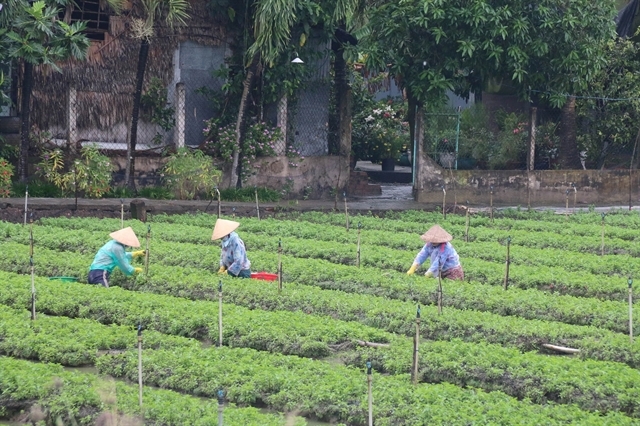 |
|
Growing vegetables in Tiền Giang Province’s Châu Thành District.
|
Growing vegetables in Tiền Giang Province’s Châu Thành District.
The Cửu Long (Mekong) Delta province of Tiền Giang has developed specialised vegetable growing areas that yield higher profits than rice.
They include vegetable areas in Châu Thành District, watermelon areas in Đồng Tháp Mười (Plain of Reeds) area, and lemongrass areas in Tân Phú Đông District.
Tân Phú Đông has more than 1,350ha of lemongrass, with an average annual yield of 15 – 17 tonnes per hectare.
The district supplies more than 22,000 tonnes of lemongrass for herbal and medicinal use a year.
Last month the district was awarded the “Tân Phú Đông Lemongrass” collective brandname by the National Office of Intellectual Property.
To meet market demand, farmers in specialised vegetable areas are growing new varieties that have high yield and quality, according to the province’s Department of Agriculture and Rural Development.
Cao Văn Hóa, deputy director of the department, said the average profit of these areas is VNĐ170 - 200 million (US$7,300 – 8,600) million per hectare a year, three to four times higher than the profit from high-yield rice.
Farmers are being encouraged to expand fields and rotate vegetables and rice on rice fields.
The province planted more than 57,700ha of vegetables in the first nine months of the year, including 10,000ha of vegetables rotated in rice fields.
Farmers are using plastic sheets to cover the ground to prevent pests and are also building nethouses.
Nguyễn Văn Ba, who grows honeydew melons in a 1,000 sq.m nethouse in Mỹ Tho City’s Mỹ Phong Commune, said that melons were not difficult to grow but that farmers needed quality seeds and new farming techniques.
Nethouse cultivation of melons uses less fertiliser and pesticides, and the plants have fewer diseases and a more stable yield, he said.
“The cultivation of honeydew melons in nethouses offer high profits,” he said.
The province’s vegetable co-operatives and co-operative groups have expanded clean vegetable cultivation to supply produce to supermarkets and collective kitchens in and outside the province.
The province’s localities are also co-operating with companies that guarantee outlets for farmers. In Châu Thành District, for instance, local authorities are working with Sài Gòn Farm, a clean vegetable growing company in HCM City, to plant clean vegetables on a 20ha area.
The area will increase to 100ha beginning in 2020, according to the district’s Agriculture and Rural Development Bureau.
Sài Gòn Farm provides farmers with advanced techniques for growing vegetables, harvesting vegetables, and initial processing.
Farmers working with companies are guaranteed outlets for their products at a fixed price, which is decided at the beginning of the crop.
Kiên Giang Province improves life for ethnic minorities
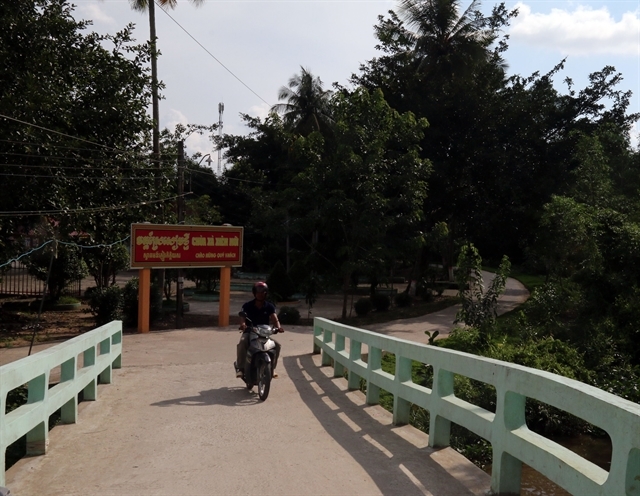 |
|
Roads in villages in Kiên Giang Province’s Châu Thành District have been cemented.
|
The lives of ethnic people in the Cửu Long (Mekong) Delta province of Kiên Giang have improved in recent years with the province implementing several measures for their socio-economic upliftment.
In 2016 -18 the province spent more than VNĐ194 billion (US$8.3 million) to build infrastructure like bridges, roads and water supply facilities in ethnic minority areas and give housing and farming land to ethnic people, according to the province’s Ethnic Minority Affairs Board.
The province also undertook many programmes and campaigns to help poor ethnic people, mobilising more than VNĐ800 billion ($34.4 million) from individual and organisational donors for the purpose.
The Kênh 2 Hamlet Khmer Women’s Union in Vĩnh Thuận District’s Tân Thuận Commune has for instance helped its members abandon backward customs and taught them effective farming models to improve their incomes.
The union’s programme of “three cleans” (clean home, clean kitchen and clean street) has improved the living conditions and reduced sickness in the hamlet.
The union established a co-operative group for rotating rice with other crops in 2013 and admitted 21 local households as members so far. They are taught farming techniques and provided with soft loans.
According to Nguyễn Ngọc Tịnh, secretary of the Kênh 2 Hamlet Party Committee, the rice yields of the participating households have increased from seven tonnes per hectare per crop to eight tonnes.
They can earn an average of VNĐ150 million ($6,445) per hectare from growing a crop of water melon, cucumber or pumpkin.
Thị Um, one of the group members, said her family used to grow two rice crops a year but the income was not enough to cover the family’s expenses.
After joining the group, her family has begun to use advanced farming techniques to increase yield.
“Thanks to the group, my family has repaid all its debts and built a new house worth VNĐ150 million,” she said.
The province Women’s Union has given VNĐ100 million ($4,300) to the Hamlet 2 Khmer Women’s Union to provide loans to the group members for growing crops.
In Giang Thành District’s Vĩnh Điều Commune, many poor Khmer households have escaped poverty through the province’s support policies.
In 2003 some 320 poor families, nearly half of them Khmer, in Giồng Riềng, Châu Thành, Gò Quao, and An Biên districts moved to live in Vĩnh Điều border commune.
After the families moved in there, local authorities built roads and power supply and irrigation systems and gave them soft loans.
Every year the commune People’s Committee calls on donors to build houses for poor Khmer people.
The commune has carried out effective farming models like raising buffalos and cows and growing lotus in rice fields.
Danh Nho, whose family was among those that migrated there, said after more than 10 years of living there and with the province’s support policies, his and other Khmer families had stable lives and houses to live in.
“My children have been educated well and have proper jobs.”
After moving to the commune, Nho was given 3ha of farmlands and money to prepare the land for growing crops.
In 2012 he received VNĐ20 million ($859) to build a house and soft loans for growing crops.
The province has 285,550 people belonging to 26 ethnic minorities, who make up 15.4 per cent of the total population.
Of them, 237,867 are Khmer.
The average income in ethnic areas increased from VNĐ29 million ($1,250) in 2015 to VNĐ39 million ($1,680) last year, said the board.
The number of poor ethnic households in the province reduced from 10,346 to 4,845.
Quảng Ngãi teachers work hard for children’s brighter future
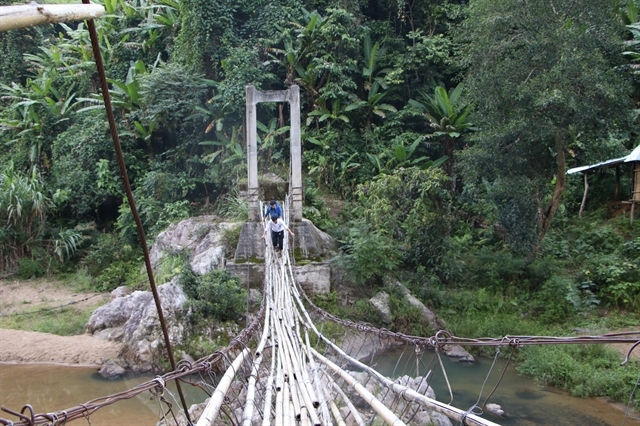 |
|
Teachers cross a suspension bridge to visit Nước Mù Village in the central province of Quảng Ngãi.
|
Nguyễn Văn Ánh, principal of Sơn Bua Primary and Secondary School, in the central province of Quảng Ngãi, walks about 3 kilometres on steep, dirt tracks and crosses a wooden bridge to Nước Mù Village to urge underprivileged students to go to school.
The village, about 4 kilometres from Sơn Bua Commune, Sơn Tây District – a remote and mountainous area of the province – has 16 households with 25 children.
The journey takes Ánh one hour.
Ánh said the new school year started nearly a month ago, but 20 students from the village are yet to return to school.
“Parents of the children are illiterate as well as too busy with farming, so they pay little attention to whether their children are going to school or not,” he said.
Đinh Văn Núi, a resident of the village, has 10 children, including seven of school age.
However, when Ánh visited Núi’s house, only one kid was attending class. The six others were at home.
Núi said he took all children to school at the beginning of the week. But maybe they were homesick, so they came home.
When seeing Ánh at their house, the children hid.
Ánh said: “Go to school tomorrow, there are lots of new textbooks and clothes. If you stay at school until the weekend, I will give you food.”
Leaving Núi’s house, Ánh visited Đinh Y Mới – a mother of a fifth-grade girl.
Mới recently moved to the village and did not know how to send her daughter to school.
Ánh told Mới to bring her daughter the following day so they could complete admission procedures.
According to Ánh, the dilapidated wooden bridge was another reason for kids to skip school. Many families felt the bridge was too dangerous to cross.
Spanning about 110 metres, the bridge collapsed and was swept away by flooding several years ago. The district’s Agriculture and Rural Development Office and the provincial Youth Union helped rebuild it.
However, due to recent flooding and storms, the suspension bridge was badly damaged. The bridge shook whenever a person crosses it, he said.
Therefore, Ánh and his collages often had to come to the students’ houses to encourage them to return to school.
Treat students like children
The school has a total of 422 students; including 200 who stay at the school.
Teachers not only teach the children but also serve meals, bathe them and take care of them at night, Ánh said.
Nguyễn Tấn Đức, a teacher, said allowing students to stay at the school started a few years ago. The plan aimed to help students continue their studies without needing to travel home, he said.
However, it also meant a lot of additional work for the teachers, Đức said.
The school now has no staff in charge of providing meals and taking care of the students.
“Teachers have to take turns to help them,” he said.
The teachers also have to look after the children at night when they sleep.
Principal Ánh said to help mountainous and remote communities access education, it would require great efforts from teachers.
"It’s not only hard work, but also dedication and enthusiasm," he said.
Teaching the students was as difficult as the journey over dirt tracks and perilous bridges, he said.
“But we still dedicate ourselves to offer the children a brighter future,” Ánh said.
Mekong Delta develops beef, dairy farming
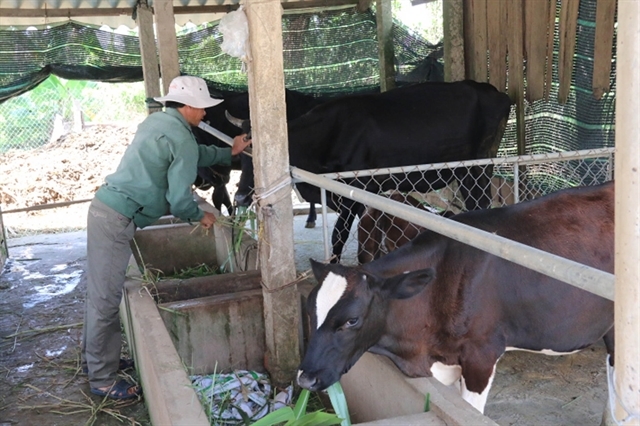 |
|
Breeding cattle in Tiền Giang Province’s Chợ Gạo District.
|
Many provinces in the Cửu Long (Mekong) Delta have developed dairy and beef farming since it provides farmers with an additional income and benefits from local agricultural by-products.
The delta, the country’s largest rice producer, produces large quantities of by-products, including rice straw for feeding cows.
In Trà Vinh, the province Department of Agriculture and Rural Development is encouraging farmers to breed cattle for meat and calves this year since there are huge volumes of agricultural by-products available locally and beef prices are high.
The price of beef cattle on the hoof is VNĐ180,000 – 190,000 (US$7- 8) a kilogramme. At these prices, farmers earn a profit of 50 per cent within one year.
Nguyễn Văn Son in Long Sơn Commune in the province’s Cầu Ngang District has stopped breeding pigs because of volatile pork prices and disease outbreaks and instead has four heads of cattle.
At current prices, he is expected to earn VNĐ7 million ($300) per animal.
According to Nguyễn Ngọc Hài, deputy director of the department, the province produces large quantities of by-products like rice straw and peanut and corn plants.
It has large tracts of lands which are not suitable for growing rice or other crops but can be used for growing grass for feeding cattle.
Trà Vinh has more than 200,000 head of cattle, 20 per cent more than a year ago.
In Tiền Giang Province, cattle breeding has developed in coastal districts like Chợ Gạo, Gò Công Đông, Gò Công Tây, and Tân Phú Đông where farming has been impacted by climate change.
Farmers in these coastal districts have also adopted the garden – pond – animal pen model to breed cattle and fish and grow crops on their land.
The province has nearly 119,000 head of cattle which are an important source of income for farmers and help mitigate rural poverty.
The delta had 748,000 cows last year, an increase of 21,600 from 2017, according to the General Statistics Office.
Support
The delta provinces have undertaken several projects to breed cattle for meat, milk and calves.
In Long An Province, the People's Committee has decided that rice, dragon fruit, vegetables, and beef will be the key products for using hi-tech techniques.
It seeks to set up a hi-tech cattle breeding area to raise more than 5,000 head for beef in Đức Hòa and Đức Huệ districts by next year.
The districts will establish at least 10 co-operative groups and co-operatives with a total of 300 household members to raise beef cattle using hi-tech farming techniques.
The province has established 10 hi-tech beef farming models based on Vietnamese good animal husbandry practices (VietGAHP) standards.
According to Võ Thanh Quang, director of the Hòa Khánh Đông Commune Beef Cattle Breeding Co-operative in Đức Hòa District, the co-operative has 16 members who raise 182 head of cattle.
Local authorities have created favourable conditions for the development of the co-operative, and its members’ awareness of hi-tech husbandry techniques has improved.
But the co-operative faced difficulties including lack of resources and poor management.
Sóc Trăng Province launched a project to raise dairy cattle in 2014, helping farmers improve their incomes, especially Khmer farmers in rural and remote areas.
Participants have been supported with soft loans for building cow sheds and buying grass cutting and milking machines.
They are also taught how to make grass and corn silages, stored rice straws and build bio-gas tanks for treating cattle waste.
There are 124 farmer groups with nearly 3,000 members participating in the project.
Their incomes have increased from VNĐ43 million ($1,850) per household per year in 2014 to VNĐ132 million ($5,680) now.
Sơn Hang, a participating farmer in Mỹ Xuyên District’s Tham Đôn Commune, said thanks to the project, the number and quality of his dairy cattle had increased.
“My family’s income has improved significantly after participating in the project.”
Sóc Trăng had nearly 9,500 dairy cattle cows as of early this year, mostly in Châu Thành, Mỹ Xuyên, Trần Đề, and Mỹ Tú districts.
Phạm Minh Tú, head of the Mỹ Tú Animal Health and Animal Husbandry Station, said through the project the district had developed many models related to cattle breeding, including for growing grass, processing food for the animals and protecting the environment.